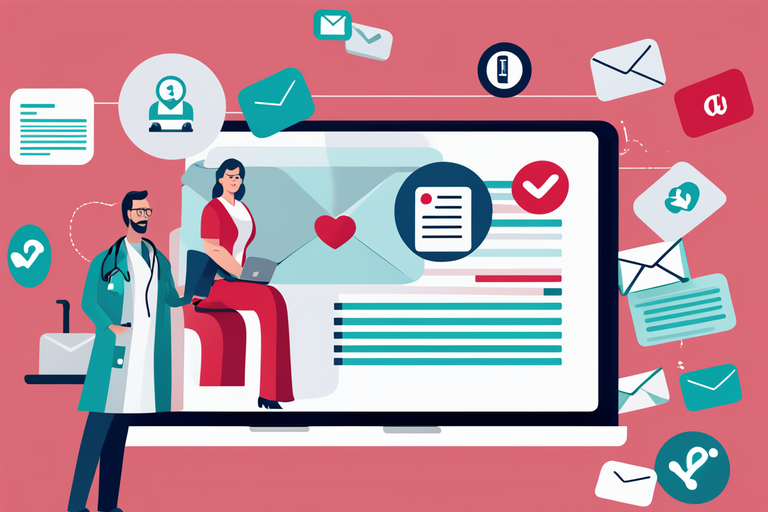Introduction
In today’s fast-paced digital world, email marketing remains a powerful tool for healthcare professionals and businesses looking to promote their products and services. However, more is needed to simply send out emails; success in healthcare email marketing requires a well-thought-out strategy. In this comprehensive guide, we will explore the ins and outs of healthcare email marketing, from building your strategy to overcoming common challenges and staying ahead of emerging trends
- Building Your Healthcare Email Marketing Strategy
- Defining Your Goals and Objectives
Setting clear goals is the foundation of any successful email marketing campaign. Whether you want to increase patient engagement, boost sales, or promote new services, your objectives should guide every email you send.
- Identifying Your Target Audience
Understanding your audience’s needs, preferences, and pain points is essential. Tailor your emails to resonate with specific patient segments for maximum impact.
- Crafting a Unique Value Proposition
What sets your healthcare services apart? Highlighting your unique value proposition helps create a compelling message that resonates with recipients.
- Selecting the Right Email Marketing Platform
Choosing the right email marketing platform is crucial. Consider factors like ease of use, automation capabilities, and compliance with healthcare regulations.
- Compliance and Legal Considerations
- Crafting Attention-Grabbing Subject Lines
Your subject line is the first thing recipients see. Create compelling and relevant subject lines that entice readers to open your emails.
- Writing Engaging and Informative Emails
The content of your emails should provide value to your recipients. Offer educational content, share healthcare tips, or provide updates on services.
- Incorporating Visuals and Multimedia
Visual content like images and videos can enhance engagement. Use them strategically to complement your message.
- Personalization for Healthcare Audiences
Personalized emails tend to perform better. Use recipient data to tailor your messages and make them more relevant.
- Building and Segmenting Your Email List
- Strategies for Growing Your Healthcare Email List
Explore various methods, such as website sign-ups, events, and referral programs, to expand your healthcare email list.
- Effective List Segmentation Techniques
Segment your email list based on demographics, patient history, or engagement levels. This allows for more targeted messaging.
- Maintaining a Clean and Healthy Email List
A clean email list is essential for deliverability and engagement. Regularly update and verify your contact information.
- Automation and Email Campaigns
- Leveraging Automation for Efficiency
Use automation to send personalized messages at the right time. Automated drip campaigns can nurture leads and maintain engagement.
- Drip Campaigns: Nurturing Healthcare Leads
Drip campaigns are a series of pre-scheduled emails designed to guide leads through the sales funnel. They provide valuable information and build trust.
- Triggered Emails for Timely Engagement
Triggered emails, based on specific actions or events, can provide timely information, such as appointment reminders or prescription refills.
- Metrics and Analytics
- Key Email Marketing Metrics to Monitor
Track important metrics like open rates, click-through rates, conversion rates, and unsubscribe rates to gauge the effectiveness of your campaigns.
- Analyzing Campaign Performance
Regularly analyze campaign performance data to identify trends and make data-driven improvements.
- Making Data-Driven Improvements
Use data insights to refine your email marketing strategy. Adjust your content, segmentation, and automation based on what works best.
- ROI Tracking for Healthcare Email Marketing
Calculate the return on investment (ROI) for your email marketing efforts to measure the impact on your bottom line.
- Case Studies and Success Stories
- Real-Life Examples of Healthcare Email Marketing
Explore case studies from successful healthcare email marketing campaigns to gain inspiration and insights.
- What Worked and Why
Analyze the strategies and tactics that led to success in these real-world examples.
- Lessons Learned from Successful Campaigns
Extract valuable lessons that you can apply to your own email marketing efforts.
- Overcoming Common Challenges
- Dealing with Email Deliverability Issues
Address common deliverability challenges like spam filters and sender reputation to ensure your emails reach inboxes.
- Managing Unengaged Subscribers
Develop strategies to re-engage subscribers who have become disinterested or inactive.
- Handling Negative Feedback
Constructive criticism can help you improve. Learn how to address negative feedback professionally and use it to refine your approach.
- Staying Updated with Industry Changes
Stay informed about changes in healthcare regulations and email marketing best practices to maintain compliance and relevance.
- Integrating Email Marketing with Other Healthcare Strategies
- Synergy with Content Marketing
Explore how email marketing can complement your content marketing efforts, such as sharing blog posts, eBooks, or videos.
- Combining Email and Social Media Efforts
Coordinate your email and social media marketing to maximize your reach and engagement.
- Coordinating Email with SEO Practices
Optimize your email content for search engines to improve visibility and drive traffic to your healthcare website.
- Aligning Email Marketing with Sales Initiatives
Ensure your email marketing efforts align with your sales goals and strategies.
Conclusion
Mastering healthcare email marketing is not only about sending messages; it’s about building meaningful connections with the target audience and effectively promoting your products and services. By crafting a well-defined strategy, staying compliant with regulations, creating engaging content, and harnessing the power of data-driven insights, businesses can leverage this invaluable tool to enhance engagement, foster trust, and ultimately achieve their goals.



